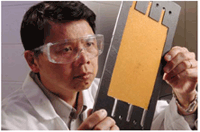|
Biorefinery Process for Making Ethanol
Argonne National Laboratory researchers are partnering with industry and other national laboratories to develop biorefineries that can compete economically with oil refineries. Argonne is one of five U.S. Department of Energy (DOE) laboratories working to replace today's motor fuel with alternative biofuels. Laboratory and industry researchers see developing alternative processes to replace the country's reliance on foreign oil as filling a national need. It is not just the price of gasoline that is affected however, as oil costs rise, so do all the costs of all petroleum-based products, including paint, plastics and carpets.
Argonne is working with Archer Daniels Midland Company (ADM) to optimize a separative bioreactor that converts sugar from corn into chemicals. R&D magazine named the technology one of this year's top R&D products. This research is supported jointly by the DOE’s Biomass Program and ADM. The Argonne-ADM effort currently focuses on demonstrating the fermentation and separation of gluconic acid on a commercial scale. "Gluconic acid is one of many bioproducts from biomass," says Seth Snyder, a biochemical engineer at Argonne, "We have to work through the processes one by one to build up an inventory to compete with petrochemical processing. We chose to start with gluconic acid because we are familiar with its processes."
Gluconic acid is produced by fermenting glucose, a type of sugar. This reaction has been known for more than 100 years. The problem with this process is that during fermentation, gluconic acid builds up until its acidity blocks the fermentation enzyme. The acidity can be chemically neutralized, but the extra treatment raises costs and generates waste.
 |
|
| Argonne scientists are working to optimize a separative bioreactor that converts sugar from corn into chemicals. |
|
In 2006, Argonne's separative bioreactor was successfully applied at the pilot scale, using a process called "electrodeionization" to overcome this acidification problem without the need for additional chemical treatments. Electrodeionization uses small amounts of electricity and Argonne's resin wafer stack to remove gluconic acid from the solution as it is produced. With the acidity kept lowremoved, the enzyme will continue to convert glucose to gluconic acid.
|